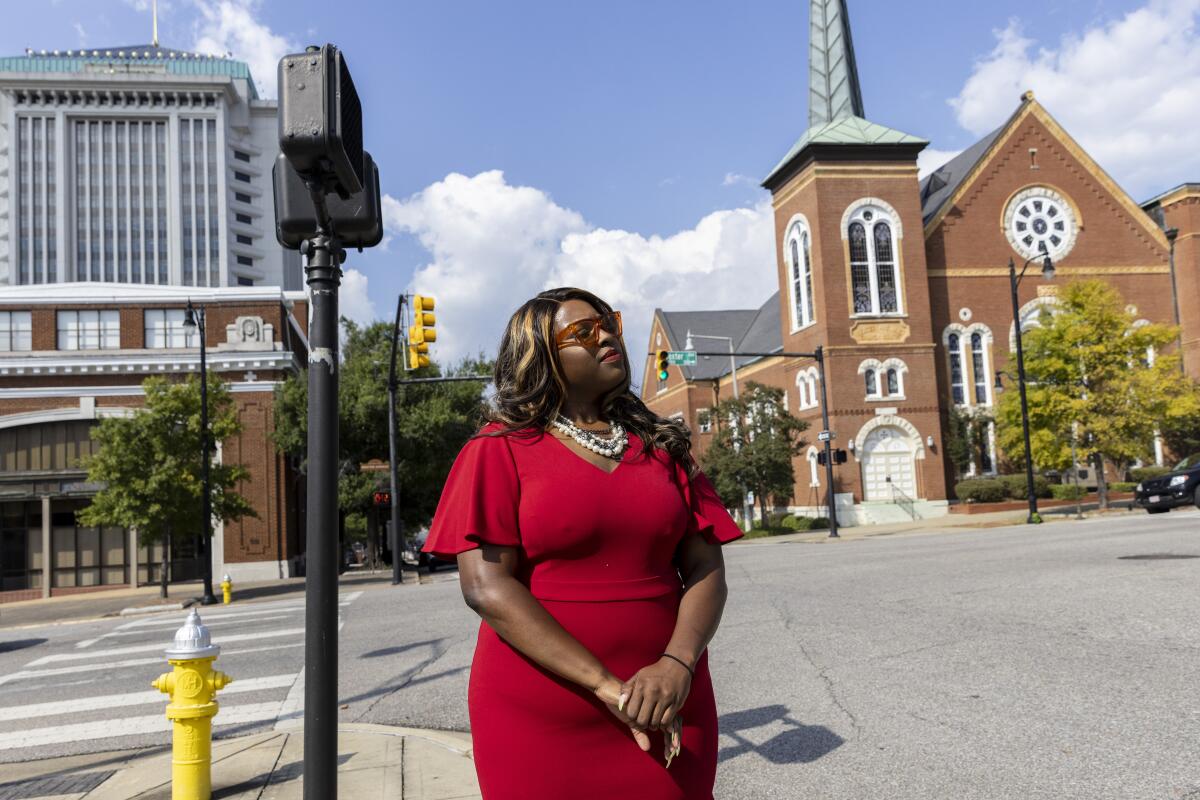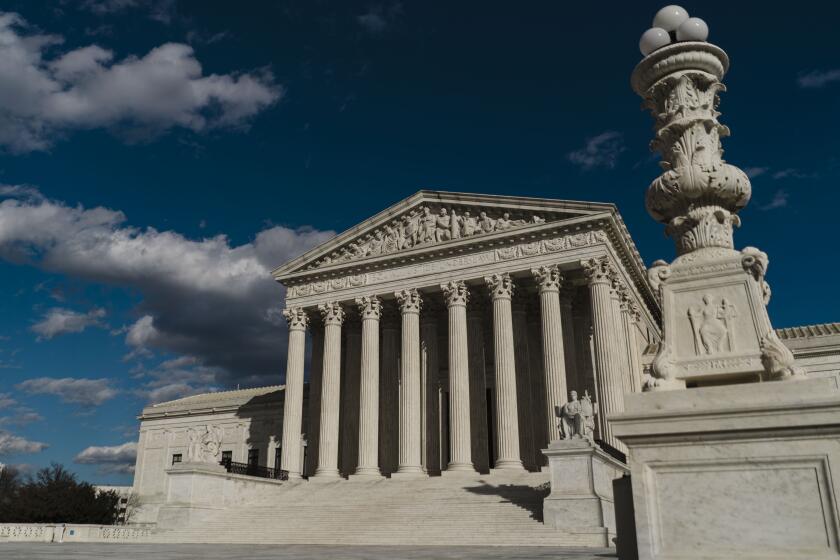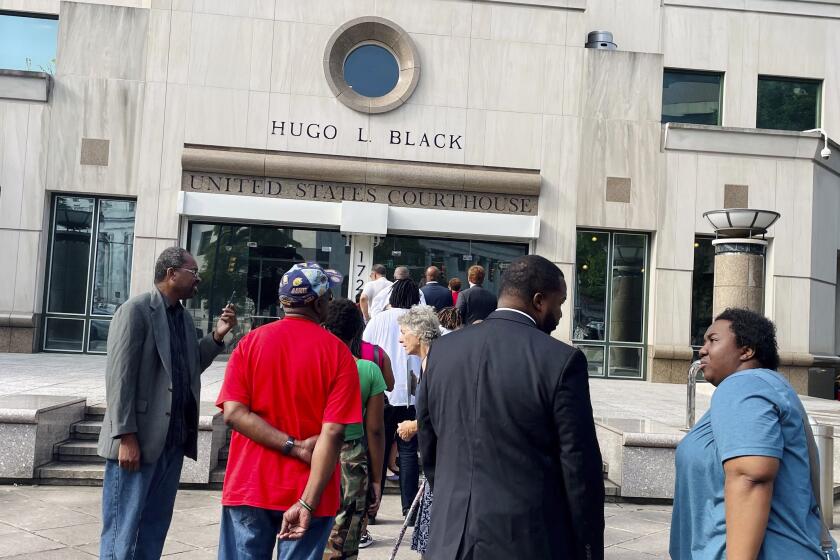A Supreme Court redistricting ruling gave hope to Black voters. They’re still waiting for new maps

- Share via
WASHINGTON — The Supreme Court’s decision siding with Black voters in an Alabama redistricting case gave Democrats and voting rights activists a surprising opportunity before the 2024 elections.
New congressional maps would have to include more districts in Alabama and potentially other states where Black voters would have a better chance of electing someone of their choice, a decision widely seen as benefiting Democrats.
It’s been more than three months since the justice’s 5-4 ruling, and maps that could produce more districts represented by Black lawmakers still do not exist.
Alabama Republicans are hoping to get a fresh hearing on the issue before the Supreme Court. Republican lawmakers in Louisiana never even bothered to draw a new map.
Khadidah Stone, a plaintiff in the Alabama case, said the continuing opposition was “appalling” but “not surprising.” She noted that Alabama is where then-Gov. George Wallace blocked Black students from integrating the University of Alabama in 1963.
“There is a long history there of disobeying court orders to deny Black people our rights,” she said.
A similar dynamic is playing out in Florida, where Republicans are appealing a ruling favorable to Black voters to the Republican-majority state Supreme Court.
Lawsuits over racially gerrymandered congressional maps in several other states, including Georgia, South Carolina and Texas, quickly followed the Supreme Court’s landmark Voting Rights Act decision in June. But the continued pushback from Republican legislatures in control of redistricting means there is great uncertainty about whether — or how soon — new maps offering equal representation for Black voters will be drawn.
The Supreme Court upholds the reach of the Voting Rights Act, ruling that Alabama must draw an election district that would likely favor a Black Democrat.
Whether the Republican strategy proves to be a defiance of court orders that the Supreme Court will shoot down or a deft political move will become clearer over the next month.
Shawn Donahue of the State University of New York at Buffalo, an expert on voting rights and redistricting, said the Supreme Court could put a quick end to the delays and “summarily affirm” the decision of a lower court panel that rejected the latest Alabama congressional map. That map continued to provide just one majority Black district out of seven in a state where Black residents comprise 27% of the population.
“You could have some of [the justices] just kind of say — ‘You know what, I didn’t agree, but that’s what the ruling was,’ ” Donahue said.
The Supreme Court also could agree to hear Alabama’s challenge, bringing the state’s redistricting plans back to the court less than a year after it rendered its opinion in the previous case.
Republicans want to keep their map in place as the state continues to fight the lower court ruling ordering them to create a second district where Black voters constitute a majority or close to it. The state contends the Supreme Court set no such remedy and that the new map complies with the court’s decision by fixing the problems it identified — such as how the state’s Black Belt region was split into multiple districts.
“A stay is warranted before voters are sorted into racially gerrymandered districts that are by their very nature odious,” the state attorney general’s office wrote in the stay request.
The stakes are high. With Republicans holding a slim majority in the U.S. House, the redistricting cases have the potential to switch control of the chamber next year.
Shortly after its decision in the Alabama case, the Supreme Court lifted its hold on a similar case from Louisiana, raising hopes among Democrats that the state would be forced to draw another Black majority congressional district.
But even if the court rejects Alabama’s latest plan, it would not necessarily bring an instant end to the case in Louisiana, where U.S. District Court Judge Shelly Dick has ruled that a second majority-Black district must be drawn.
Dick has three days of hearings scheduled to begin Oct. 3. But her initial order blocking the 2022 congressional map drawn by Louisiana’s GOP-controlled Legislature — which maintains white majorities in five of six districts in a state where about one-third of voters are Black — remains on appeal. The 5th U.S. Circuit Court of Appeals is to hear arguments Oct. 6.
Louisiana’s lawyers argue that the Black communities the plaintiffs and the district court seek to include in a second majority Black district are too far-flung, even under the Alabama precedent.
The high court’s decision in the Alabama case “did not present a free pass to future plaintiffs to establish [Voting Rights Act] liability without proving that the relevant minority population is itself compact,” Louisiana said in its argument.
The voting rights advocates suing the state argue that the plans they have suggested so far are “on average more compact” than the plan the state is trying to preserve.
Alabama’s new congressional map is rejected after lawmakers failed to create a district in which Black voters at least come close to comprising a majority.
Stuart Naifeh, who is a plaintiff as part of the NAACP Legal Defense and Educational Fund, said in Louisiana that the court is considering the maps drawn by only the plaintiffs because the Legislature chose not to draw any. Louisiana state Rep. Sam Jenkins Jr., a Democrat, said he is optimistic now that the matter is in the courts.
“We had the opportunity to do the right thing, which would have been fair for all the people of Louisiana,” he said. “I am disappointed that the court still has to come in and make our state do what is right.”
Louisiana’s argument against a second district has less merit than Alabama’s, said state Sen. Royce Duplessis, a Democrat. Louisiana has just one majority Black congressional district out of six even though Black residents account for one-third of the state’s population. That lone district encompasses New Orleans and Baton Rouge.
“These are two distinct cities, two distinct regions, two distinct interests and needs, and it only makes sense to have these two large communities to anchor individual congressional districts,” Duplessis said. “We have shown that there is a multitude of ways to draw a map that has two majority Black districts that meet all the criteria for fair redistricting.”
A similar case is playing out in Florida, though not in federal court.
A state judge ruled earlier this month that a redistricting plan pushed by Gov. Ron DeSantis, a GOP presidential contender, should be redrawn because it diminishes the ability of Black voters in north Florida to pick a representative of their choice.
The state is appealing that ruling, and the case might be fast-tracked to the Florida Supreme Court, where five of the seven justices were appointed by DeSantis. Both sides are requesting a quick resolution before the next legislative session in case districts need to be redrawn for the 2024 elections.
The new map essentially drew Democratic U.S. Rep. Al Lawson, who is Black, out of office by carving up his district and dividing a large number of Black voters into conservative districts represented by white Republicans. DeSantis contended the previous district extended 200 miles just to link Black communities, violating the constitutional standards for compactness.
Angie Nixon, a Black state representative from Jacksonville, was one of the Democratic lawmakers who led a protest against the DeSantis map. She said she is still hopeful the state’s high court will ultimately deliver the outcome wanted by voting rights groups.
Nixon said groups have been organizing to get more people engaged.
“We are going to use this as an opportunity to serve as a catalyst to get people moving and get people out to vote,” she said.
More to Read
Sign up for Essential California
The most important California stories and recommendations in your inbox every morning.
You may occasionally receive promotional content from the Los Angeles Times.












